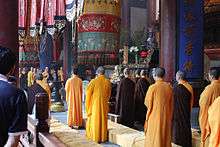Chinese Buddhism
Chinese Buddhism or Han Buddhism has shaped Chinese culture in a wide variety of areas including art, politics, literature, philosophy, medicine and material culture.
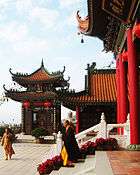
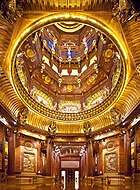
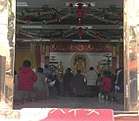
❷ Cross-schools cultural centres: Inner view of the Brahma Palace of the Buddhist Vatican (simplified Chinese: 梵宮; traditional Chinese: 梵宫; pinyin: fàn gōng) in Wuxi, Jiangsu, mainland China, focus of Chinese Buddhist and other East Asian Buddhist schools.
❸ Lay movements: A Buddhist house church (居士林 jūshìlín), part of a movement of lay Buddhist congregations, in Beijing.
| Part of a series on |
| Chinese Buddhism 汉传佛教 / 漢傳佛教 |
|---|
 Chinese: "Buddha" |
|
Major figures |
|
Architecture |
The translation of a large body of Indian Buddhist scriptures into Chinese and the inclusion of these translations together with works composed in China into a printed canon had far-reaching implications for the dissemination of Buddhism throughout the East Asian cultural sphere, including Taiwan, Korea, Japan and Vietnam. Chinese Buddhism is also marked by the interaction between Indian religions, Chinese religion and Taoism.
History
Han Dynasty (206 BCE–220 CE)
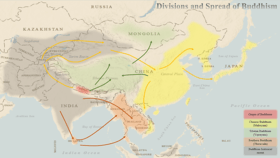
Various legends tell of the presence of Buddhism in Chinese soil in very ancient times. While the scholarly consensus is that Buddhism first came to China in the first century CE during the Han dynasty, through missionaries from India,[1] it actually is not known precisely when Buddhism entered China.
Generations of scholars have debated whether Buddhist missionaries first reached Han China via the maritime or overland routes of the Silk Road. The maritime route hypothesis, favored by Liang Qichao and Paul Pelliot, proposed that Buddhism was originally practiced in southern China, the Yangtze River and Huai River region. On the other hand, it must have entered from the northwest via the Kansu corridor to the Yellow River basin and the North China Plain in the course of the first century A.D. The scene becomes clearer from the middle of the second century onward, when the first known missionaries started their translation activities in the capital, Lo-yand. The Book of the Later Han records that in 65 CE, prince Liu Ying of Chu (present day Jiangsu) "delighted in the practices of Huang-Lao Daoism" and had both Buddhist monks and laypeople at his court who presided over Buddhist ceremonies.[2] The overland route hypothesis, favored by Tang Yongtong, proposed that Buddhism disseminated through Central Asia – in particular, the Kushan Empire, which was often known in ancient Chinese sources as Da Yuezhi ("Great Yuezhi"), after the founding tribe. According to this hypothesis, Buddhism was first practiced in China in the Western Regions and the Han capital Luoyang (present day Henan), where Emperor Ming of Han established the White Horse Temple in 68 CE.
In 2004, Rong Xinjiang, a history professor at Peking University, reexamined the overland and maritime hypotheses through a multi-disciplinary review of recent discoveries and research, including the Gandhāran Buddhist Texts, and concluded:
The view that Buddhism was transmitted to China by the sea route comparatively lacks convincing and supporting materials, and some arguments are not sufficiently rigorous. Based on the existing historical texts and the archaeological iconographic materials discovered since the 1980s, particularly the first-century Buddhist manuscripts recently found in Afghanistan, the commentator believes that the most plausible theory is that Buddhism reached China from the Greater Yuezhi of northwest India and took the land route to reach Han China. After entering into China, Buddhism blended with early Daoism and Chinese traditional esoteric arts and its iconography received blind worship.[3]
The French sinologist Henri Maspero says it is a "very curious fact" that, throughout the entire Han dynasty, Daoism and Buddhism were "constantly confused and appeared as single religion".[4] A century after prince Liu Ying's court supported both Daoists and Buddhists, in 166 Emperor Huan of Han made offerings to the Buddha and sacrifices to the Huang-Lao gods Yellow Emperor and Laozi. [5] The first Chinese apologist for Buddhism, a late 2nd-century layman named Mouzi, said it was through Daoism that he was led to Buddhism—which he calls dàdào (大道, the "Great Dao").
I too, when I had not yet understood the Great Way (Buddhism), had studied Taoist practises. Hundreds and thousands of recipes are there for longevity through abstention from cereals. I practised them, but without success; I saw them put to use, but without result. That is why I abandoned them.[6]
Early Chinese Buddhism was conflated and mixed with Daoism, and it was within Daoist circles that it found its first adepts. Traces are evident in Han period Chinese translations of Buddhist scriptures, which hardly differentiated between Buddhist nirvana and Daoist immortality. Wuwei, the Daoist concept of non-interference, was the normal term for translating Sanskrit nirvana, which is transcribed as nièpán (涅槃) in modern Chinese usage.[7]
Traditional accounts

A number of popular accounts in historical Chinese literature have led to the popularity of certain legends regarding the introduction of Buddhism into China. According to the most popular one, Emperor Ming of Han (28–75 CE) precipitated the introduction of Buddhist teachings into China. The (early 3rd to early 5th century) Mouzi Lihuolun first records this legend:
In olden days Emperor Ming saw in a dream a god whose body had the brilliance of the sun and who flew before his palace; and he rejoiced exceedingly at this. The next day he asked his officials: "What god is this?" the scholar Fu Yi said: "Your subject has heard it said that in India there is somebody who has attained the Dao and who is called Buddha; he flies in the air, his body had the brilliance of the sun; this must be that god."[8]
The emperor then sent an envoy to Tianzhu (Southern India) to inquire about the teachings of the Buddha.[9] Buddhist scriptures were said to have been returned to China on the backs of white horses, after which White Horse Temple was named. Two Indian monks also returned with them, named Dharmaratna and Kaśyapa Mātaṅga.
An 8th-century Chinese fresco at Mogao Caves near Dunhuang in Gansu portrays Emperor Wu of Han (r. 141–87 BCE) worshiping statues of a golden man; "golden men brought in 121 BCE by a great Han general in his campaigns against the nomads". However, neither the Shiji nor Book of Han histories of Emperor Wu mentions a golden Buddhist statue (compare Emperor Ming above).
The first translations
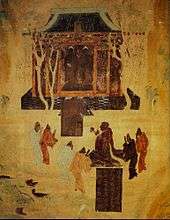
The first documented translation of Buddhist scriptures from various Indian languages into Chinese occurs in 148 CE with the arrival of the Parthian prince-turned-monk An Shigao (Ch. 安世高). He worked to establish Buddhist temples in Luoyang and organized the translation of Buddhist scriptures into Chinese, testifying to the beginning of a wave of Central Asian Buddhist proselytism that was to last several centuries. An Shigao translated Buddhist texts on basic doctrines, meditation, and abhidharma. An Xuan (Ch. 安玄), a Parthian layman who worked alongside An Shigao, also translated an early Mahāyāna Buddhist text on the bodhisattva path.
Mahāyāna Buddhism was first widely propagated in China by the Kushan monk Lokakṣema (Ch. 支婁迦讖, active c. 164–186 CE), who came from the ancient Buddhist kingdom of Gandhāra. Lokakṣema translated important Mahāyāna sūtras such as the Aṣṭasāhasrikā Prajñāpāramitā Sūtra, as well as rare, early Mahāyāna sūtras on topics such as samādhi, and meditation on the buddha Akṣobhya. These translations from Lokakṣema continue to give insight into the early period of Mahāyāna Buddhism. This corpus of texts often includes emphasizes ascetic practices and forest dwelling, and absorption in states of meditative concentration:[10]
Paul Harrison has worked on some of the texts that are arguably the earliest versions we have of the Mahāyāna sūtras, those translated into Chinese in the last half of the second century CE by the Indo-Scythian translator Lokakṣema. Harrison points to the enthusiasm in the Lokakṣema sūtra corpus for the extra ascetic practices, for dwelling in the forest, and above all for states of meditative absorption (samādhi). Meditation and meditative states seem to have occupied a central place in early Mahāyāna, certainly because of their spiritual efficacy but also because they may have given access to fresh revelations and inspiration.
Early Buddhist schools

During the early period of Chinese Buddhism, the Indian early Buddhist schools recognized as important, and whose texts were studied, were the Dharmaguptakas, Mahīśāsakas, Kāśyapīyas, Sarvāstivādins, and the Mahāsāṃghikas.[12]
The Dharmaguptakas made more efforts than any other sect to spread Buddhism outside India, to areas such as Afghanistan, Central Asia, and China, and they had great success in doing so.[13] Therefore, most countries which adopted Buddhism from China, also adopted the Dharmaguptaka vinaya and ordination lineage for bhikṣus and bhikṣuṇīs. According to A.K. Warder, in some ways in those East Asian countries, the Dharmaguptaka sect can be considered to have survived to the present.[14] Warder further writes that the Dharmaguptakas can be credited with effectively establishing Chinese Buddhism during the early period:[15]
It was the Dharmaguptakas who were the first Buddhists to establish themselves in Central Asia. They appear to have carried out a vast circling movement along the trade routes from Aparānta north-west into Iran and at the same time into Oḍḍiyāna (the Suvastu valley, north of Gandhāra, which became one of their main centres). After establishing themselves as far west as Parthia they followed the "silk route", the east-west axis of Asia, eastwards across Central Asia and on into China, where they effectively established Buddhism in the second and third centuries A.D. The Mahīśāsakas and Kāśyapīyas appear to have followed them across Asia into China. [...] For the earlier period of Chinese Buddhism it was the Dharmaguptakas who constituted the main and most influential school, and even later their Vinaya remained the basis of the discipline there.
Six Dynasties (220–589)
Early translation methods
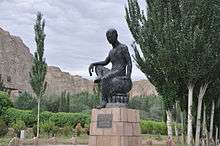

Initially, Buddhism in China faced a number of difficulties in becoming established. The concept of monasticism and the aversion to social affairs seemed to contradict the long-established norms and standards established in Chinese society. Some even declared that Buddhism was harmful to the authority of the state, that Buddhist monasteries contributed nothing to the economic prosperity of China, that Buddhism was barbaric and undeserving of Chinese cultural traditions.[16] However, Buddhism was often associated with Taoism in its ascetic meditative tradition, and for this reason a concept-matching system was used by some early Indian translators, to adapt native Buddhist ideas onto Daoist ideas and terminology.[17][18]
Buddhism appealed to Chinese intellectuals and elites and the development of gentry Buddhism was sought as an alternative to Confucianism and Daoism, since Buddhism's emphasis on morality and ritual appealed to Confucianists and the desire to cultivate inner wisdom appealed to Daoists. Gentry Buddhism was a medium of introduction for the beginning of Buddhism in China, it gained imperial and courtly support. By the early 5th century Buddhism was established in south China.[19] During this time, Indian monks continued to travel along the Silk Road to teach Buddhism, and translation work was primarily done by foreign monks rather than Chinese.
The arrival of Kumārajīva (334–413 CE)
When the famous monk Kumārajīva was captured during the Chinese conquest of the Buddhist kingdom of Kucha, he was imprisoned for many years. When he was released in AD 401, he immediately took a high place in Chinese Buddhism and was appraised as a great master from the West. He was especially valued by Emperor Yao Xing of the state of Later Qin, who gave him an honorific title and treated him like a god. Kumārajīva revolutionized Chinese Buddhism with his high quality translations (from AD 402–413), which are still praised for their flowing smoothness, clarity of meaning, subtlety, and literary skill. Due to the efforts of Kumārajīva, Buddhism in China became not only recognized for its practice methods, but also as high philosophy and religion. The arrival of Kumārajīva also set a standard for Chinese translations of Buddhist texts, effectively doing away with previous concept-matching systems.
The translations of Kumārajīva have often remained more popular than those of other translators. Among the most well-known are his translations of the Diamond Sutra, the Amitabha Sutra, the Lotus Sutra, the Vimalakīrti Nirdeśa Sūtra, the Mūlamadhyamakakārikā, and the Aṣṭasāhasrikā Prajñāpāramitā Sūtra.
A completed Sūtra Piṭaka
Around the time of Kumārajīva, the four major Sanskrit āgamas were also translated into Chinese. Each of the āgamas was translated independently by a different Indian monk. These āgamas comprise the only other complete surviving Sūtra Piṭaka, which is generally comparable to the Pali Sutta Pitaka of Theravada Buddhism. The teachings of the Sūtra Piṭaka are usually considered to be one of the earliest teachings on Buddhism and a core text of the Early Buddhist Schools in China. It is noteworthy that before the modern period, these āgama were seldom if ever used by Buddhist communities, due to their Hīnayāna attribution, as Chinese Buddhism was already avowedly Mahāyāna in persuasion.
Early Chinese Buddhist traditions
Due to the wide proliferation of Buddhist texts available in Chinese and the large number of foreign monks who came to teach Buddhism in China, much like new branches growing from a main tree trunk, various specific focus traditions emerged. Among the most influential of these was the practice of Pure Land Buddhism established by Hui Yuan, which focused on Amitābha Buddha and his western pure land of Sukhāvatī. Other early traditions were the Tiantai, Huayan and the Vinaya school.[20] Such schools were based upon the primacy of the Lotus Sūtra, the Avataṃsaka Sūtra, and the Dharmaguptaka Vinaya, respectively, along with supplementary sūtras and commentaries. The Tiantai founder Zhiyi wrote several works that became important and widely read meditation manuals in China such as the "Concise samatha-vipasyana", and the "Great samatha-vipasyana."
Daily life of nuns
An important aspect of a nun was the practice of a vegetarian as it was heavily emphasized in the Buddhist religion to not harm any living creature for the purpose of them to consume. There were also some nuns who did not eat regularly, as an attempt of fasting. Another dietary practice of nuns was their practice of consuming fragrant oil or incense as a “preparation for self- immolation by fire.”[21]
Some daily activities of nuns include the reading, memorizing, and reciting of Buddhist scriptures and religious text. Another was mediation as it is seen as the “heart of Buddhist monastic life.” There are biographers explaining when nuns mediate they enter a state where their body of becomes hard, rigid, and stone-like where they are often mistaken as lifeless.[22]
Southern and Northern Dynasties (420–589) and Sui Dynasty (589–618 CE)
Chán: pointing directly to the mind
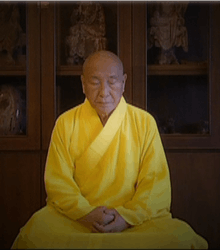
In the 5th century, the Chán (Zen) teachings began in China, traditionally attributed to the Buddhist monk Bodhidharma, a legendary figure.[note 1] The school heavily utilized the principles found in the Laṅkāvatāra Sūtra, a sūtra utilizing the teachings of Yogācāra and those of Tathāgatagarbha, and which teaches the One Vehicle (Skt. Ekayāna) to buddhahood. In the early years, the teachings of Chán were therefore referred to as the "One Vehicle School."[34] The earliest masters of the Chán school were called "Laṅkāvatāra Masters", for their mastery of practice according to the principles of the Laṅkāvatāra Sūtra.
The principal teachings of Chán were later often known for the use of so-called encounter stories and koans, and the teaching methods used in them. Nan Huai-Chin identifies the Laṅkāvatāra Sūtra and the Diamond Sūtra (Vajracchedikā Prajñāpāramitā Sūtra) as the principle texts of the Chán school, and summarizes the principles succinctly:
The Zen teaching was a separate transmission outside the scriptural teachings that did not posit any written texts as sacred. Zen pointed directly to the human mind to enable people to see their real nature and become buddhas.[35]
Tang Dynasty (618–907 CE)
Xuanzang's journey to the west


During the early Tang dynasty, between 629 and 645, the monk Xuanzang journeyed to India and visited over one hundred kingdoms, and wrote extensive and detailed reports of his findings, which have subsequently become important for the study of India during this period. During his travels he visited holy sites, learned the lore of his faith, and studied with many famous Buddhist masters, especially at the famous center of Buddhist learning at Nālanda University. When he returned, he brought with him some 657 Sanskrit texts. Xuanzang also returned with relics, statues, and Buddhist paraphernalia loaded onto twenty-two horses.[36] With the emperor's support, he set up a large translation bureau in Chang'an (present-day Xi'an), drawing students and collaborators from all over East Asia. He is credited with the translation of some 1,330 fascicles of scriptures into Chinese. His strongest personal interest in Buddhism was in the field of Yogācāra, or "Consciousness-only".
The force of his own study, translation and commentary of the texts of these traditions initiated the development of the Faxiang school in East Asia. Although the school itself did not thrive for a long time, its theories regarding perception, consciousness, karma, rebirth, etc. found their way into the doctrines of other more successful schools. Xuanzang's closest and most eminent student was Kuiji who became recognized as the first patriarch of the Faxiang school. Xuanzang's logic, as described by Kuiji, was often misunderstood by scholars of Chinese Buddhism because they lack the necessary background in Indian logic.[37] Another important disciple was the Korean monk Woncheuk.
Xuanzang's translations were especially important for the transmission of Indian texts related to the Yogācāra school. He translated central Yogācāra texts such as the Saṃdhinirmocana Sūtra and the Yogācārabhūmi Śāstra, as well as important texts such as the Mahāprajñāpāramitā Sūtra and the Bhaiṣajyaguruvaidūryaprabharāja Sūtra (Medicine Buddha Sūtra). He is credited with writing or compiling the Cheng Weishi Lun (Vijñaptimātratāsiddhi Śāstra) as composed from multiple commentaries on Vasubandhu's Triṃśikā-vijñaptimātratā. His translation of the Heart Sūtra became and remains the standard in all East Asian Buddhist sects. The proliferation of these texts expanded the Chinese Buddhist canon significantly with high quality translations of some of the most important Indian Buddhist texts.
Caves, art, and technology
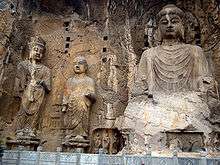
The popularization of Buddhism in this period is evident in the many scripture-filled caves and structures surviving from this period. The Mogao Caves near Dunhuang in Gansu province, the Longmen Grottoes near Luoyang in Henan and the Yungang Grottoes near Datong in Shanxi are the most renowned examples from the Northern, Sui and Tang Dynasties. The Leshan Giant Buddha, carved out of a hillside in the 8th century during the Tang dynasty and looking down on the confluence of three rivers, is still the largest stone Buddha statue in the world.
Monks and pious laymen spread Buddhist concepts through story-telling and preaching from sutra texts. These oral presentations were written down as bianwen (transformation stories) which influenced the writing of fiction by their new ways of telling stories combining prose and poetry. Popular legends in this style included Mulian Rescues His Mother, in which a monk descends into hell in a show of filial piety.
Making duplications of Buddhist texts was considered to bring meritorious karma. Printing from individually carved wooden blocks and from clay or metal movable type proved much more efficient than hand copying and eventually eclipsed it. The Diamond Sūtra (Vajracchedikā Prajñāpāramitā Sūtra) of 868 CE, a Buddhist scripture discovered in 1907 inside the Mogao Caves, is the first dated example of block printing.[38]
Arrival of Esoteric Buddhism
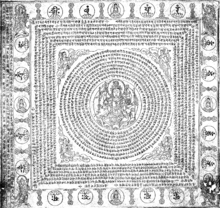
The Kaiyuan's Three Great Enlightened Masters, Śubhakarasiṃha, Vajrabodhi, and Amoghavajra, established Esoteric Buddhism in China from AD 716 to 720 during the reign of emperor Xuanzong. They came to Daxing Shansi (大興善寺, Great Propagating Goodness Temple), which was the predecessor of Temple of the Great Enlightener Mahavairocana. Daxing Shansi was established in the ancient capital Chang'an, today's Xi'an, and became one of the four great centers of scripture translation supported by the imperial court. They had translated many Buddhist scriptures, sutra and tantra, from Sanskrit to Chinese. They had also assimilated the prevailing teachings of China: Daoism and Confucianism, with Buddhism, and had further evolved the practice of the Esoteric school.
They brought to the Chinese a mysterious, dynamic, and magical teaching, which included mantra formula and detailed rituals to protect a person or an empire, to affect a person's fate after death, and, particularly popular, to bring rain in times of drought. It is not surprising, then, that all three masters were well received by the emperor Tang Xuanzong, and their teachings were quickly taken up at the Tang court and among the elite. Mantrayana altars were installed in temples in the capital, and by the time of emperor Tang Daizong (r. 762–779) its influence among the upper classes outstripped that of Daoism. However, relations between Amoghavajra and Daizong were especially good. In life the emperor favored Amoghavajra with titles and gifts, and when the master died in 774, he honored his memory with a stupa, or funeral monument. The Esoteric Buddhist lineage of China (and almost all of Buddhism in China at the time) was nearly wiped out by the Emperor Tang Wuzong, leading to the Great Anti-Buddhist Persecution. Historically, the Hanmi Chinese Esoteric School of Buddhism was also thought to have been lost when Emperor Tang Wuzong banned the teaching. Master Huiguo, the last known disciple of Amoghavajra, foresaw this. He was happy to see the arrival of Japanese student monk Kūkai and tried to teach him every details in Esoteric Buddhism at that time, consisting of two major divisions, the Womb Realm and the Diamond Realm. Master Kukai went back to Japan to establish the Japanese Esoteric school of Buddhism, later known as Shingon Buddhism. Huiguo died shortly after his meeting with Kukai and not long before Emperor Wuzong's persecution.
The Esoteric Buddhist lineages transmitted to Japan under the auspices of the monks Kūkai and Saicho, later formulated the teachings transmitted to them to create the Shingon sect and the Tendai sect.
Tang state repression of 845

There were several components that led to opposition of Buddhism. One factor is the foreign origins of Buddhism, unlike Taoism and Confucianism. Han Yu wrote, "Buddha was a man of the barbarians who did not speak the language of China and wore clothes of a different fashion. His sayings did not concern the ways of our ancient kings, nor did his manner of dress conform to their laws. He understood neither the duties that bind sovereign and subject, nor the affections of father and son."
Other components included the Buddhists' withdrawal from society, since the Chinese believed that Chinese people should be involved with family life. Wealth, tax-exemption status and power of the Buddhist temples and monasteries also annoyed many critics.[42]
As mentioned earlier, persecution came during the reign of Emperor Wuzong in the Tang dynasty. Wuzong was said to hate the sight of Buddhist monks, who he thought were tax-evaders. In 845, he ordered the destruction of 4,600 Buddhist monasteries and 40,000 temples. More than 400,000 Buddhist monks and nuns then became peasants liable to the Two Taxes (grain and cloth).[43] Wuzong cited that Buddhism was an alien religion, which is the reason he also persecuted the Christians in China. David Graeber argues that Buddhist institutions had accumulated so much precious metals which the government needed to secure the money supply.[44] Ancient Chinese Buddhism never fully recovered from the persecution.[45][46]
Five Dynasties and Ten Kingdoms Period (907–960/979)

The Five Dynasties and Ten Kingdoms period (五代十国; 五代十國; Wǔdài Shíguó) was an era of political upheaval in China, between the fall of the Tang dynasty and the founding of the Song dynasty. During this period, five dynasties quickly succeeded one another in the north, and more than 12 independent states were established, mainly in the south. However, only ten are traditionally listed, hence the era's name, "Ten Kingdoms". Some historians, such as Bo Yang, count eleven, including Yan and Qi, but not Northern Han, viewing it as simply a continuation of Later Han. This era also led to the founding of the Liao dynasty.
After the fall of the Tang dynasty, China was without effective central control during the Five Dynasties and Ten Kingdoms period. China was divided into several autonomous regions. Support for Buddhism was limited to a few areas. The Hua-yen and T'ien-t'ai schools suffered from the changing circumstances, since they had depended on imperial support. The collapse of T'ang society also deprived the aristocratic classes of wealth and influence, which meant a further drawback for Buddhism. Shenxiu's Northern Chán School and Henshui's Southern Chán School didn't survive the changing circumstances. Nevertheless, Chán emerged as the dominant stream within Chinese Buddhism, but with various schools developing various emphasises in their teachings, due to the regional orientation of the period. The Fayan school, named after Fa-yen Wen-i (885–958) became the dominant school in the southern kingdoms of Nan-T'ang (Jiangxi, Chiang-hsi) and Wuyue (Che-chiang).[47]
Song Dynasty (960–1279)

The Song dynasty is divided into two distinct periods: the Northern Song and Southern Song. During the Northern Song (北宋, 960–1127), the Song capital was in the northern city of Bianjing (now Kaifeng) and the dynasty controlled most of inner China. The Southern Song (南宋, 1127–1279) refers to the period after the Song lost control of northern China to the Jin dynasty. During this time, the Song court retreated south of the Yangtze River and established their capital at Lin'an (now Hangzhou). Although the Song Dynasty had lost control of the traditional birthplace of Chinese civilization along the Yellow River, the Song economy was not in ruins, as the Southern Song Empire contained 60 percent of China's population and a majority of the most productive agricultural land.[48]
During the Song dynasty, Chán (禪) was used by the government to strengthen its control over the country, and Chán grew to become the largest sect in Chinese Buddhism. An ideal picture of the Chán of the Tang period was produced, which served the legacy of this newly acquired status.[49]
In the early Song dynasty "Chán-Pure Land syncretism became a dominant movement."[50] Buddhist ideology began to merge with Confucianism and Daoism, due in part to the use of existing Chinese philosophical terms in the translation of Buddhist scriptures. Various Confucian scholars of the Song dynasty, including Zhu Xi (wg: Chu Hsi), sought to redefine Confucianism as Neo-Confucianism.
During the Song dynasty, in 1021 CE, it is recorded that there were 458,855 Buddhist monks and nuns actively living in monasteries.[43] The total number of monks was 397,615, while the total number of nuns was recorded as 61,240.[43]
Mongol Yuan rule (1279–1368)
During the Mongol Yuan domination, the Mongol emperors made Esoteric Buddhism an official religion of their empire which China was a part of, and Tibetan lamas were given patronage at the court.[51] A common perception was that this patronage of lamas caused corrupt forms of tantra to become widespread.[51] When the Mongol Yuan dynasty was overthrown and the Ming dynasty was established, the Tibetan lamas were expelled from the court, and this form of Buddhism was denounced as not being an orthodox path.[51]
Ming dynasty (1368–1644)
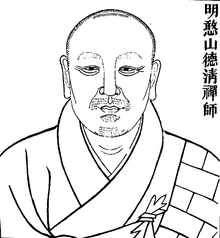
According to Weinstein, by the Ming dynasty, the Chan school was so firmly established that all monks were affiliated with either the Linji school or the Caodong school.[52]
Eminent Monks
During the Ming dynasty, Hanshan Deqing was one of the great reformers of Chinese Buddhism.[53] Like many of his contemporaries, he advocated the dual practice of the Chán and Pure Land methods, and advocated the use of the nianfo ("Mindfulness of the Buddha") technique to purify the mind for the attainment of self-realization.[53] He also directed practitioners in the use of mantras as well as scripture reading. He was also renowned as a lecturer and commentator and admired for his strict adherence to the precepts.[53]
According to Jiang Wu, for Chan masters in this period such as Hanshan Deqing, training through self-cultivation was encouraged, and clichéd or formulaic instructions were despised.[54] Eminent monks who practiced meditation and asceticism without proper Dharma transmission were acclaimed for having acquiring "wisdom without a teacher."[54]
Eminent Nuns
During the Ming Dynasty, women of different ages were able to enter the monastic life from as young as five or six years old to seventy years old.[55] There were various reasons why a Ming woman entered the religious life of becoming a nun. Some women had fallen ill and believed by entering the religious life they were able to relieve their sufferings.[56] There were other women, who had become widowed due to the death of her husband or betrothed so out of choice chose to join a convent.[57] Many women who were left widowed were affected financially as they often had to support their in-laws, and parents, therefore, joining a convent was not a bad option. By devoting themselves to religion, they received less social criticism from society because during the Ming time women were expected to remain faithful to their husband. An example of this is Xia Shuji. Xia's husband Hou Xun, (1591-1645), had led a resistance in Jiading which arrested the Qing troops who later on beheaded him.[58] Xia Shuji who secluded herself from the outside life to devote herself to religion and took on the religious name of Shengyin.[59]
During the time of late Ming, a period of social upheaval, the monastery or convent provided shelter for these women who no longer had protection from a male in their family: husband, son or father due to death, financial constraint and other situations.[55] However, in most circumstances, a woman who wanted to join a nunnery was because they wanted to escape a marriage or they felt isolated as her husband has died- she also had to overcome many difficulties that arose socially from this decision. For most of these women, a convent was seen as a haven to escape their family or an unwanted marriage. Such difficulties were due to the social expectation of the women as it was considered unfilial to leave their duty as a wife, daughter, mother or daughter in law.[60] There were also some cases where some individuals were sold by their family to earn money in a convent by reciting sutras, and performing Buddhist services because they weren't able to financially support them.[61] Jixing entered into a religious life as a young girl due to the fact that her family had no money to raise her.[62]
Lastly, there were some who became part of the Buddhist convent because of a spiritual calling where they found comfort to the religious life, an example would be Zhang Ruyu.[63] Zhang took the religious name, Miaohui, and just before she entered the religious life she wrote the poem below:
Drinking at Rain and Flowers Terrace,
I Compose a Description the Falling Leaves
For viewing the vita, a 1000-chi terrace.
For discussing the mind, a goblet of wine.
A pure frost laces the tips of the trees,
Bronze leaves flirt with the river village.
Following the wave, I float with the oars;
Gory and decay, why sign over them?
This day, I’ve happily returned to the source.[64]
Through her poetry, Miaohui (Zhang Ruyu) she conveys the emotions of fully understanding and concluding the difference in the life outside without devotion to religion and the life in a monastery, known as the Buddhist terms between “form and emptiness.”[65] Women like Miaohui, Zhang, had found happiness and fulfillment in the convent that they could not seek in the outside world. Despite the many reasons for entering the religious life, most women had to obtain permission from a male in their life (father, husband, or son).[66] Most of the nuns who have entered the religious life seclude themselves from the outside life away from their family and relatives.
Worshipped
Most nuns participated in religious practices with devotions to many different bodhisattva and Buddha. Some examples of bodhisattvas are Guan Yin, Amita Buddha, Maitreya, and Pindola.
One of the most prominent bodhisattvas in Chinese Buddhism is Guanyin, known as Goddess of Compassion, Mercy and Love is also a protector and savior for those who worship and needs Guanyin's aid.[67]
Qing dynasty (1644–1911)

The Qing court endorsed the Gelukpa School of Tibetan Buddhism.[68] Early in the Taiping rebellion, the Taiping rebels targeted Buddhism. In the Battle of Nanjing (1853), the Taiping army butchered thousands of monks in Nanjing. But from the middle of the Taiping rebellion, Taiping leaders took a more moderate approach, demanding that monks should have licences.
Around 1900, Buddhists from other Asian countries showed a growing interest in Chinese Buddhism. Anagarika Dharmapala visited Shanghai in 1893,[69] intending "to make a tour of China, to arouse the Chinese Buddhists to send missionaries to India to restore Buddhism there, and then to start a propaganda throughout the whole world", but eventually limiting his stay to Shanghai.[69] Japanese Buddhist missionaries were active in China in the beginning of the 20th century.[69]
Republic of China (established 1912)

The modernisation of China led to the end of the Chinese Empire, and the installation of the Republic of China, which lasted on the mainland until the Communist Revolution and the installation of the People's Republic of China in 1949 which also led to the ROC government's exodus to Taiwan.
Under influence of the western culture, attempts were being made to revitalize Chinese Buddhism.[70] Most notable were the Humanistic Buddhism of Taixu, and the revival of Chinese Chán by Hsu Yun.[70] Hsu Yun is generally regarded as one of the most influential Buddhist teachers of the 19th and 20th centuries. Other influential teachers in the early 20th century included Pure land Buddhist Yin Guang (印光)[71] and artist Hong Yi. Layman Zhao Puchu worked much on the revival.
Until 1949, monasteries were built in the Southeast Asian countries, for example by monks of Guanghua Monastery, to spread Chinese Buddhism. Presently, Guanghua Monastery has seven branches in the Malay Peninsula and Indonesia.[72] Several Chinese Buddhist teachers left mainland China during the Communist Revolution, and settled in Hong Kong and Taiwan.
Master Hsing Yun (1927–present) is the founder of Fo Guang Shan monastery and lay organization the Buddha's Light International Association. Born in Jiangsu Province in mainland China, he entered the Sangha at the age of 12, and came to Taiwan in 1949. He founded Fo Guang Shan monastery in 1967, and the Buddha's Light International Association in 1992. These are among the largest monastic and lay Buddhist organizations in Taiwan from the late 20th to early 21st centuries. He advocates Humanistic Buddhism, which the broad modern Chinese Buddhist progressive attitude towards the religion.
Master Sheng Yen (1930–2009) was the founder of the Dharma Drum Mountain, a Buddhist organization based in Taiwan. During his time in Taiwan, Sheng Yen was well known as one of the progressive Buddhist teachers who sought to teach Buddhism in a modern and Western-influenced world.
Master Wei Chueh was born in 1928 in Sichuan, mainland China, and ordained in Taiwan. In 1982, he founded Lin Quan Temple in Taipei County and became known for his teaching on Ch'an practices by offering many lectures and seven-day Ch'an retreats.
People's Republic of China (established 1949)
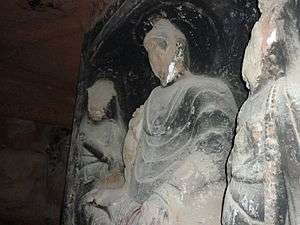
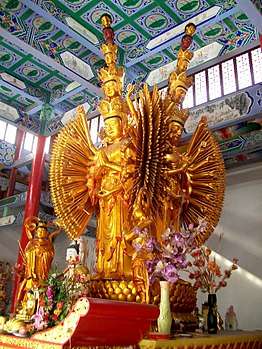
Chinese Buddhist Association
Unlike Catholicism and other branches of Christianity, there was no organization in China that embraced all monastics in China, nor even all monastics within the same sect. Traditionally each monastery was autonomous, with authority resting on each respective abbot. In 1953, the Chinese Buddhist Association was established at a meeting with 121 delegates in Beijing. The meeting also elected a chairman, 4 honorary chairmen, 7 vice-chairmen, a secretary general, 3 deputy secretaries-general, 18 members of a standing committee, and 93 directors. The 4 elected honorary chairmen were the Dalai Lama, the Panchen Lama, the Grand Lama of Inner Mongolia, and Venerable Master Hsu Yun.[73]
Reform and opening up – Second Buddhist Revival
Since the reform and opening up period in the 1970s, a new revival of Chinese Buddhism has been taking place.[74][75][76][77] Ancient Buddhist temples are being restored and new Buddhist temples are being built.
Chinese Buddhist temples, administrated by local governments, have become increasingly commercialized by sales of tickets, incense, or other religious items; soliciting donations; and even the listing of temples on the stock market and local governments obtain large incomes. In October 2012, the State Administration for Religious Affairs announced a crackdown on religious profiteering.[78] Many sites have done enough repairs and have already cancelled ticket fares and are receiving voluntary donation instead.[79][80]
The 108-metre-high Guan Yin of the South Sea of Sanya statue was enshrined on April 24, 2005 with the participation of 108 eminent monks from various Buddhist groups from Mainland China, Hong Kong, Macao and Taiwan, and tens of thousands of pilgrims. The delegation also included monks from the Theravada and Tibetan Buddhist traditions.[81][82] China is one of the countries with the most of the world's highest statues, many of which are Buddhist statues.
In April 2006 China organized the World Buddhist Forum, an event now held every two years, and in March 2007 the government banned mining on Buddhist sacred mountains.[83] In May of the same year, in Changzhou, the world's tallest pagoda was built and opened.[84][85][86] In March 2008 the Taiwan-based organizations Tzu Chi Foundation and Fo Guang Shan were approved to open a branch in mainland China.[87][88]
Currently, there are about 1.3 billion Chinese living in the People's Republic. Surveys have found that around 18.2% to 20% of this population adheres to Buddhism.[89] Furthermore, PEW found that another 21% of the Chinese population followed Chinese folk religions that incorporated elements of Buddhism.[90]
Chinese Buddhism in Southeast Asia
Chinese Buddhism is mainly practiced by ethnic Han-Chinese in Southeast Asia.
Chinese Buddhism in the West
The first Chinese master to teach Westerners in North America was Hsuan Hua, who taught Chán and other traditions of Chinese Buddhism in San Francisco during the early 1960s. He went on to found the City Of Ten Thousand Buddhas, a monastery and retreat center located on a 237-acre (959,000 m²) property near Ukiah, California. Chuang Yen Monastery and Hsi Lai Temple are also large centers.
Sheng Yen also founded dharma centers in the USA.
With the rapid increase of immigrants from mainland China to Western countries in the 1980s, the landscape of the Chinese Buddhism in local societies has also changed over time. Based on fieldwork research conducted in France, some scholars categorize three patterns in the collective Buddhism practice among Chinese Buddhists in France: An ethnolinguistic immigrant group, a transnational organizational system, and information technology. These distinctions are made according to the linkages of globalization.
In the first pattern, religious globalization is a product of immigrants’ transplantation of local cultural traditions. For example, people of similar immigration experiences establish a Buddha hall (佛堂) within the framework of their associations for collective religious activities.
The second pattern features the transnational expansion of a large institutionalized organization centered on a charismatic leader, such as Fo Guang Shan (佛光山), Tzu Chi (慈濟) and Amitabha Buddhist Society (淨宗學會).
In the third pattern, religious globalization features the use of information technology such as websites, blogs, Emails and social media to ensure direct interaction between members in different places and between members and their leader. The Buddhist organization led by Jun Hong Lu is a typical example of this kind of group.[91]
Sects
Esoteric Buddhism
In China and countries with large Chinese populations such as Taiwan, Malaysia, and Singapore, Esoteric Buddhism is most commonly referred to as the Chinese term Mìzōng (密宗), or "Esoteric School." Traditions of Chinese Esoteric Buddhism are most commonly referred to as Tángmì (唐密), "Tang Dynasty Esoterica," or Hànchuán Mìzōng (漢傳密宗), "Han Transmission Esoteric School" (Hànmì 漢密 for short), or Dōngmì (東密), "Eastern Esoterica," separating itself from Tibetan and Newar traditions. These schools more or less share the same doctrines as Shingon, and in some cases, Chinese monks have traveled to Japan to train and to be given esoteric transmission at Mount Kōya and Mount Hiei.
Unrecognised sects
There are many sects and organisations proclaiming a Buddhist identity and pursuit (fo or fu: "awakening", "enlightenment") that are not recognised as legitimate Buddhism by the Chinese Buddhist Association and the government of the People's Republic of China. This group includes:
- Guanyin Buddhism [Awakening Teaching] (观音佛教 Guānyīn Fójiào) or Guanyin Church (观音会 Guānyīn Huì)[92]
- True Awakening Tradition (真佛宗 Zhēnfó Zōng)
- Buddhism [Awakening Teaching] of the Lord of Heaven of Infinite Thriving of the Mountain of Longevity (寿山万隆天主佛教 Shòushān Wànlóng Tiānzhǔ Fójiào)
- Wulian Jingang Dadao ("Great Way of the Innumerable Attendants of Awakening")
Teachings
Basic concepts
Chinese Buddhism incorporates elements of traditional Buddhism and Taoism.
Common practices include
- worship of Buddhas and bodhisattvas
- through offerings of incense, flowers, food, etc.
- offerings to Devas who reside in the heavenly realm
- paying respect to dead ancestors during Qingming and Hungry Ghost festival
- performance of religious ceremonies to help souls of the deceased find peace (超渡)
- forming affinities with other people, through gifts and acts of service (緣份)
- vegetarianism: monastics are required to be vegetarian, devout laity are also often vegetarian
- compassion towards all living beings through activities such as "life release"
Common beliefs include
- existence of gods, ghosts and hell realm
- reincarnation (超生), or more technically, rebirth, according to one's karma
- karmic retribution (報應), ethically cause and effect
Incense burning
Burning incense, translated to “shaoxiang” in Chinese, is a traditional and ubiquitous religious practice for almost all pujas, prayers, and other forms of worship. During the Zhou dynasty, Chinese believed that smoke resulting from burning wood act as a bridge between the human world and the spirits.[93] When Buddhism reached China, this wood evolved into sandalwood incense which were originally burned by Indian Buddhists so they could concentrate better.[93] India is the home of Buddhism, and has formed its characteristic convention of burning incense. A uniform and codified system of incense-making first begin in India.
The philosophy behind incense burning is to sacrifice oneself for the benefit of others, the true spirit of Buddhism. The specific knowledge of incense as a healing tool was assimilated into the religious practices of the time, specifically early Hinduism.
It can be seen that incense burning as it is known today is a merger between Chinese culture and Buddhist culture.
Laypeople in Chinese Buddhism

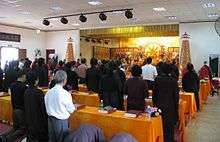
In Chinese Buddhism, lay practitioners have traditionally played an important role, and lay practice of Buddhism has had similar tendencies to those of monastic Buddhism in China.[94] Many historical biographies of lay Buddhists are available, which give a clear picture of their practices and role in Chinese Buddhism. In addition to these numerous biographies, there are accounts from Jesuit missionaries such as Matteo Ricci which provide extensive and revealing accounts to the degree Buddhism penetrated elite and popular culture in China.[94]
Traditional practices such as meditation, mantra recitation, mindfulness of Amitābha Buddha, asceticism, and vegetarianism were all integrated into the belief systems of ordinary people.[94] It is known from accounts in the Ming Dynasty that lay practitioners often engaged in practices from both the Pure Land and Chán traditions, as well as the study of the Buddhist sūtras. The Heart Sūtra and the Diamond Sūtra were the most popular, followed by the Lotus Sūtra and the Avataṃsaka Sūtra.[94]
Laypeople were also commonly devoted to the practice of mantras, and the Mahā Karuṇā Dhāraṇī and the Cundī Dhāraṇī were very popular.[94] Robert Gimello has also observed that in Chinese Buddhist communities, the esoteric practices of Cundī enjoyed popularity among both the populace and the elite.[95]
Mahāyāna figures such as Avalokiteśvara Bodhisattva, Kṣitigarbha Bodhisattva, Amitābha Buddha, and the Medicine Buddha, were all widely known and revered. Beliefs in karma and rebirth were held at all levels of Chinese society, and pilgrimages to well-known monasteries and the four holy mountains of China were undertaken by monastics and lay practitioners alike.[94]
Festivals
These are the holy days that Chinese Buddhists celebrate by visiting temples to make offerings of prayers, incense, fruits, flowers and donations. On such days they observe the moral precepts very strictly as well as a full day's vegetarian diet, a practice originally from China.
The dates given are based on the Chinese calendar system so that 8.4 means the Eighth day of the fourth month in Chinese calendar and so on.[96]
- 8.12 — Enlightenment Day of Śākyamuni Buddha
- 1.1 — Birthday of Maitreya Buddha
- 9.1 — Birthday of Śakra, Lord of the Devas
- 8.2 — Renunciation Day of Śākyamuni Buddha
- 15.2 — Mahāparinirvāṇa Day of Śākyamuni Buddha
- 19.2 — Birthday of Bodhisattva Avalokiteśvara (Guan Yin)
- 21.2 — Birthday of Bodhisattva Samantabhadra
- 4.4 — Birthday of Bodhisattva Mañjuśrī
- 8.4 — Birthday of Śākyamuni Buddha
- 15.4 — Vesak Day
- 13.5 — Birthday of Bodhisattva Sangharama (Qie Lan)
- 3.6 — Birthday of Skanda (Wei Tuo)
- 19.6 — Enlightenment Day of Bodhisattva Avalokiteśvara
- 13.7 — Birthday of Bodhisattva Mahāsthāmaprāpta
- 15.7 — Ullambana Festival Ghost Festival
- 24.7 — Birthday of Bodhisattva Nagarjuna
- 30.7 — Birthday of Bodhisattva Kṣitigarbha
- 22.8 — Birthday of Dīpaṃkara Buddha (an ancient buddha)
- 19.9 — Renunciation Day of Bodhisattva Avalokiteśvara
- 30.9 — Birthday of Bhaiṣajyaguru Buddha (Medicine Buddha)
- 5.10 — Anniversary of the death of Bodhidharma
- 17.11 — Birthday of Amitābha Buddha
See also
- Budai
- Buddhism in South Asia
- Buddhism in Southeast Asia
- Buddhism by country
- Buddhism in Sri Lanka
- Buddhist Association of China
- Buddhism and Eastern religions
- Buddhist deities
- Chan Buddhism
- Chinese Buddhist canon
- Chinese Buddhist cuisine
- Chinese Esoteric Buddhism
- Chinese philosophy
- Dharma Drum Retreat Center
- History of Buddhism
- Index of Buddhism-related articles
- List of Buddhist architecture in China
- List of converts to Buddhism
- Neo-Confucianism
- Religion in Asia
- Religion in China and Chinese lists of cults
- Secular Buddhism
- Schools of Buddhism
- Shingon Buddhism
- Silk Road transmission of Buddhism
- Three Disasters of Wu
- Persecution of Buddhists in People's Republic of China
- Timeline of Buddhism
Notes
- Little contemporary biographical information on Bodhidharma is extant, and subsequent accounts became layered with legend.[23] There are three principal sources for Bodhidharma's biography:[24] Yáng Xuànzhī's (Yang Hsüan-chih) The Record of the Buddhist Monasteries of Luoyang (547), Tánlín's preface to the Two Entrances and Four Acts (6th century CE), which is also preserved in Ching-chüeh's Chronicle of the Lankavatar Masters (713–716),[25] and Dàoxuān's (Tao-hsuan) Further Biographies of Eminent Monks (7th century CE).These sources, given in various translations, vary on their account of Bodhidharma being either:
- "[A] monk of the Western Region named Bodhidharma, a Persian Central Asian"[26] c.q. "from Persia"[27] (Buddhist monasteries, 547);
- "[A] South Indian of the Western Region. He was the third son of a great Indian king."[28] (Tanlin, 6th century CE);
- "[W]ho came from South India in the Western Regions, the third son of a great Brahman king"[29] c.q. "the third son of a Brahman king of South India" [27] (Lankavatara Masters, 713–716[25]/ca. 715[27]);
- "[O]f South Indian Brahman stock"[30] c.q. "a Brahman monk from South India"[27] (Further Biographies, 645).
References
Citations
- 中国文化科目认证指南. 华语教学出版社. Sinolingua. 2010. p. 64. ISBN 978-7-80200-985-1.
公元1世纪———传入中国内地,与汉文化交融,形成汉传佛教。
- Maspero 1981, pp. 401, 405.
- Rong Xinjiang, 2004, Land Route or Sea Route? Commentary on the Study of the Paths of Transmission and Areas in which Buddhism Was Disseminated during the Han Period, tr. by Xiuqin Zhou, Sino-Platonic Papers 144, pp. 26–27.
- Maspero 1981, p. 405.
- Maspero 1981, p. 406.
- Maspero 1981, p. 406.
- Maspero 1981, p. 409
- Tr. by Henri Maspero, 1981, Taoism and Chinese Religion, tr. by Frank A. Kierman Jr., University of Massachusetts Press, p. 402.
- Hill (2009), p. 31.
- Williams, Paul. Mahāyāna Buddhism: The Doctrinal Foundations. 2008. p. 30
- Label for item no. 1992.165.21 in the Metropolitan Museum of Art
- Warder, A.K. Indian Buddhism. 2000. p. 281
- Warder, A.K. Indian Buddhism. 2000. p. 278
- Warder, A.K. Indian Buddhism. 2000. p. 489
- Warder, A.K. Indian Buddhism. 2000. pp. 280–281
- Bentley, Jerry. Old World Encounters: Cross-Cultural Contacts and Exchanges in Pre-Modern Times 1993. p. 82
- Oh, Kang-nam (2000). The Taoist Influence on Hua-yen Buddhism: A Case of the Sinicization of Buddhism in China. Chung-Hwa Buddhist Journal, No. 13, (2000). Source: (accessed: January 28, 2008) p.286 Archived March 23, 2010, at the Wayback Machine
- Further discussion of can be found in T'ang, Yung-t'ung, "On 'Ko-I'," in Inge et al. (eds.): Radhakrishnan: Comparative Studies in Philosophy Presented in Honour of His Sixtieth Birthday (London: Allen and Unwin, 1951) pp. 276–286 (cited in K. Ch'en, pp. 68 f.)
- Jerry Bentley "Old World Encounters: Cross-Cultural Contacts and Exchanges in Pre-Modern Times" (New York: Oxford University Press, 1993), 78.
- 法鼓山聖嚴法師數位典藏. Archived from the original on 2013-05-28. Retrieved 2013-07-29.
- Kathryn Ann Tsai, Lives Of The Nuns. (Honolulu: University of Hawaii Press), pp. 10.
- Kathryn Ann Tsai, Lives Of The Nuns., pp. 11.
- McRae 2003.
- Dumoulin 2005, p. 85–90.
- Dumoulin 2005, p. 88.
- Broughton 1999, p. 54–55.
- McRae 2003, p. 26.
- Broughton 1999, p. 8.
- Dumoulin 2005, p. 89.
- Dumoulin 2005, p. 87.
- Kambe & (year unknown).
- Zvelebil 1987, p. 125–126.
- Masato Tojo, Zen Buddhism and Persian Culture
- The Platform Sutra of the Sixth Patriarch, translated with notes by Philip B. Yampolsky, 1967, Columbia University Press, ISBN 0-231-08361-0, page 29, note 87
- Basic Buddhism: exploring Buddhism and Zen, Nan Huai-Chin, 1997, Samuel Weiser, page 92.
- Jerry Bentley, "Old World Encounters: Cross-Cultural Contacts and Exchanges in Pre-Modern Times" (New York: Oxford University Press, 1993), 81.
- See Eli Franco, "Xuanzang's proof of idealism." Horin 11 (2004): 199–212.
- "Diamond Sutra". Landmarks in Printing. The British Library. Archived from the original on 2005-03-06. Retrieved 2008-09-12.
- von Le Coq, Albert. (1913). Chotscho: Facsimile-Wiedergaben der Wichtigeren Funde der Ersten Königlich Preussischen Expedition nach Turfan in Ost-Turkistan Archived 2016-09-15 at the Wayback Machine. Berlin: Dietrich Reimer (Ernst Vohsen), im Auftrage der Gernalverwaltung der Königlichen Museen aus Mitteln des Baessler-Institutes, Tafel 19 Archived 2016-09-15 at the Wayback Machine. (Accessed 3 September 2016).
- Ethnic Sogdians have been identified as the Caucasian figures seen in the same cave temple (No. 9). See the following source: Gasparini, Mariachiara. "A Mathematic Expression of Art: Sino-Iranian and Uighur Textile Interactions and the Turfan Textile Collection in Berlin," in Rudolf G. Wagner and Monica Juneja (eds), Transcultural Studies, Ruprecht-Karls Universität Heidelberg, No 1 (2014), pp 134–163. ISSN 2191-6411. See also endnote #32. (Accessed 3 September 2016.)
- For information on the Sogdians, an Eastern Iranian people, and their inhabitation of Turfan as an ethnic minority community during the phases of Tang Chinese (7th–8th century) and Uyghur rule (9th–13th century), see Hansen, Valerie (2012), The Silk Road: A New History, Oxford University Press, p. 98, ISBN 978-0-19-993921-3.
- Palumbo, Antonello (2017). "Exemption Not Granted: The Confrontation between Buddhism and the Chinese State in Late Antiquity and the ›First Great Divergence‹ Between China and Western Eurasia". Medieval Worlds. medieval worlds (Volume 6. 2017): 118–155. doi:10.1553/medievalworlds_no6_2017s118. ISSN 2412-3196.
- Gernet, Jacques. Verellen, Franciscus. Buddhism in Chinese Society. 1998. pp. 318-319
- Graeber, David (2011). Debt: The First 5000 Years. Brooklyn, NY: Melville House. pp. 265–6. ISBN 978-1-933633-86-2.
- Wm. Theodore de Bary (editor) (2008). Sources of East Asian Tradition, Vol. 1: Premodern Asia. Columbia University Press. p. 306. ISBN 978-0-231-14305-9.CS1 maint: extra text: authors list (link)
- History of Spreading Archived May 12, 2013, at the Wayback Machine
- Welter 2000, p. 86–87.
- Ebrey 2006, p. 167.
- McRae 1993, p. 119–120.
- Heng-Ching Shih (1987). Yung-Ming's Syncretism of Pure Land and Chan, The Journal of the International Association of Buddhist Studies 10 (1), p. 117
- Nan Huai-Chin. Basic Buddhism: Exploring Buddhism and Zen. York Beach: Samuel Weiser. 1997. p. 99.
- Stanley Weinstein, "The Schools of Chinese Buddhism," in Kitagawa & Cummings (eds.), Buddhism and Asian History (New York: Macmillan 1987) pp. 257–265, 264.
- Keown, Damien. A Dictionary of Buddhism. 2003. p. 104
- Jiang Wu. Enlightenment in Dispute. 2008. p. 41
- Kathryn Ann Tsai, Lives Of The Nuns. (Honolulu: University of Hawaii Press), pp. 6.
- Yunu Chen, “Buddhism and the Medical Treatment of Women in the Ming Dynasty.” Na Nu (2008):, pp. 290.
- Beata Grant, “Setting the Stage: Seventeenth-Century Texts and Contexts.” In Eminent Nuns: Women Chan Masters of Seventeenth-Century China (Honolulu: University of Hawai'i Press.), pp. 4. Retrieved from http://www.jstor.org/stable/j.ctt6wqcxh.6
- Beata Grant, “Setting the Stage: Seventeenth-Century Texts and Contexts.” In Eminent Nuns: Women Chan Masters of Seventeenth-Century China pp., 5.
- Beata Grant, “Setting the Stage: Seventeenth-Century Texts and Contexts.” In Eminent Nuns: Women Chan Masters of Seventeenth-Century China., pp. 6.
- Beata Grant., and Wilt Idema, “Empresses, Nuns, and Actresses. In The Red Brush: Writing Women of Imperial China. (Cambridge (Massachusetts); London: Harvard University Asia Center), pp. 157. Retrieved from https://www.jstor.org/stable/j.ctt1tg5kw2.
- Yunu Chen, “Buddhism and the Medical Treatment of Women in the Ming Dynasty.” Na Nu (2008):, pp. 295.
- Beata Grant, Daughters of Emptiness Poems of Chinese Buddhist Nuns. (Boston: Wisdom Publication), pp. 56.
- Karma Lekshe Tsomo, Buddhist Women Across Cultures. (New York: State University of New York Press), pp. 98.
- Karma Lekshe Tsomo, Buddhist Women Across Cultures., pp. 99.
- Karma Lekshe Tsomo, Buddhist Women Across Cultures. (New York: State University of New York Press), pp. 100.
- Kathryn Ann Tsai, Lives Of The Nuns. (Honolulu: University of Hawaii Press), pp. 7.
- Wilt Idema. Personal Salvation And Filial Piety: Two Precious Scroll Narratives of Guanyin and her Acolytes. (Honolulu: University of Hawaii Press), pp. 6.
- Mullin 2001, p. 358
- Lewis Hodus (1923), Buddhism and Buddhists in China. Chapter IX: Present-Day Buddhism
- Huai-Chin 1999.
- 重現一代高僧的盛德言教
- Voice of Longquan, Guanghua Monastery Archived December 18, 2012, at the Wayback Machine
- Holmes, Welch (1961). "Buddhism Under the Communists", China Quarterly, No.6, Apr-June 1961, pp. 1–14.
- Laliberte 2011.
- Lai 2003.
- Mitch Moxley (2010), Buddhism Enjoys A Revival
- Erica B. Mitchell (201), A Revival of Buddhism? Archived July 14, 2014, at the Wayback Machine
- "Commercialization of temples in China prompts ban on stock listings, crackdown on profiteering". Beijing: Washington Post. Associated Press. 2012-10-26. Retrieved 2012-10-26.
- 湖南29家寺院取消门票免费开放-中新网 - 中国新闻网
- 净慧法师呼吁全国佛教名山大寺一律免费开放_佛教频道_凤凰网
- Giant Buddhist Statue Enshrined in Hainan
- Holy statue of Guanyin Buddha unveiled
- "China bans mining on sacred Buddhist mountains". Reuters. 2007-08-23.
- "China temple opens tallest pagoda". BBC News. 2007-05-01. Retrieved 2010-04-27.
- Photo in the News: Tallest Pagoda Opens in China
- China inaugurates 'world's tallest pagoda' - INQUIRER.net, Philippine News for Filipinos
- Tzu Chi Foundation Approved To Open Branch In Mainland China - ChinaCSR.com - Corporate Social Responsibility (CSR) News and Information for China Archived July 5, 2008, at the Wayback Machine
- 中國評論新聞網.
- "Buddhists | Pew Research Center". 2012-12-18.
- "Life in Purgatory: Buddhism in China".
- Ji, Zhe (2014-01-14). "Buddhist Groups among Chinese Immigrants in France: Three Patterns of Religious Globalization". Review of Religion and Chinese Society. 1 (2): 212–235. doi:10.1163/22143955-04102006b. ISSN 2214-3947.
- Munro (1994), p. 269–271.
- 中央研究院網站.
- Twitchett, Denis, and Fairbank, John. The Cambridge History of China, Volume 8, Part 2. 1998. p. 949
- Jiang, Wu (2008). Enlightenment in Dispute: The Reinvention of Chan Buddhism in Seventeenth-Century China: p. 146
- "2020 Buddhist Calendar" (PDF). Retrieved 2020-01-04.
Sources
- Broughton, Jeffrey L. (1999), The Bodhidharma Anthology: The Earliest Records of Zen, Berkeley: University of California Press, ISBN 978-0-520-21972-4
- Chen, Kenneth Kuan Sheng. Buddhism in China: A historical survey. Princeton, N.J., Princeton University Press, 1964.
- Dumoulin, Heinrich (2005), Zen Buddhism: A History, 1: India and China, Bloomington, IN: World Wisdom, ISBN 978-0-941532-89-1
- Han Yu. "Sources of Chinese Tradition. c. 800.
- Ebrey, Patricia Buckley (1999), The Cambridge Illustrated History of China, Cambridge: Cambridge University Press, ISBN 978-0-521-66991-7 (paperback).
- Hill, John E. (2009) Through the Jade Gate to Rome: A Study of the Silk Routes during the Later Han Dynasty, 1st to 2nd Centuries CE. John E. Hill. BookSurge, Charleston, South Carolina. ISBN 978-1-4392-2134-1.
- Hodus, Lewis (1923), Buddhism and Buddhists in China
- Kambe, Tstuomu, Bodhidharma. A collection of stories from Chinese literature (PDF), archived from the original (PDF) on 2015-11-06, retrieved 2013-02-19
- Lai, Hongyi Harry (2003), The Religious Revival in China. In: Copenhagen Journal of Asian Studies 18
- Laliberte, Andre (2011), Buddhist Revival under State Watch, in: Journal of Current Chinese Affairs, 40, 2,107-134
- Liebenthal, Walter. Chao Lun - The Treatises of Seng-Chao Hong Kong, China, Hong Kong University Press, 1968
- Liebenthal, Walter. Was ist chinesischer Buddhismus Asiatische Studien: Zeitschrift der Schweizerischen Asiengesellschaft, 1952 http://data.datacite.org/10.5169/seals-145467
- McRae, John R. (2000), "The Antecedents of Encounter Dialogue in Chinese Ch'an Buddhism", in Heine, Steven; Wright, Dale S. (eds.), The Kōan: Texts and Contexts in Zen Buddhism, Oxford University Press
- McRae, John (2003), Seeing Through Zen, The University Press Group Ltd
- Mullin, Glenn H.The Fourteen Dalai Lamas: A Sacred Legacy of Reincarnations (2001) Clear Light Publishers. ISBN 1-57416-092-3
- Saunders, Kenneth J. (1923). "Buddhism in China: A Historical Sketch", The Journal of Religion, Vol. 3.2, pp. 157–169; Vol. 3.3, pp. 256–275.
- Welch, Holmes. The practice of Chinese Buddhism. Cambridge, Massachusetts: Harvard University Press, 1967.
- Welch, Holmes. The Buddhist revival in China. Cambridge, Massachusetts: Harvard University Press, 1968.
- Welch, Holmes. Buddhism under Mao. Cambridge, Massachusetts: Harvard University Press, 1972.
- Welter, Albert (2000), Mahakasyapa's smile. Silent Transmission and the Kung-an (Koan) Tradition. In: Steven Heine and Dale S. Wright (eds)(2000): "The Koan. Texts and Contexts in Zen Buddhism, Oxford: Oxford University Press
- Yang, Fenggang; Wei, Dedong, THE BAILIN BUDDHIST TEMPLE: THRIVING UNDER COMMUNISM (PDF), archived from the original (PDF) on June 6, 2010
- Zhu, Caifang (2003), Buddhism in China Today: The Example of the Bai Lin Chan Monastery. Perspectives, Volume 4, No.2, June 2003 (PDF), archived from the original (PDF) on 2010-09-29
- Zvelebil, Kamil V. (1987), "The Sound of the One Hand", Journal of the American Oriental Society, 107 (1): 125–126, doi:10.2307/602960, JSTOR 602960
Further reading
History
- Nan Huai-Chin (1998), Basic Buddhism: Exploring Buddhism and Zen, Translated by J.C. Cleary, Red Wheel Weiser
- Nan Huai-Chin (1995), The Story of Chinese Zen, Translated by Thomas Cleary, Charles E. Tuttle Company
- Tansen Sen (2003), Buddhism, Diplomacy, and Trade: The realignment of Sino-Indian Relations, 600–1400, Association for Asian Studies & University of Hawai'i Press
- Shinko Mochizuki, Leo M. Pruden, Trans. (1999). Pure Land Buddhism in China: A Doctrinal History, Chapter 1: A General Survey. In: Pacific World Journal, Third Series, Number 1, 91–103. Archived from the original
- Shinko Mochizuki, Leo M. Pruden, Trans. (2001). Pure Land Buddhism in China: A Doctrinal History, Chapter 2: The Earliest Period; Chapter 3: Hui-yuan of Mt.Lu; and Chapter 4: The Translation of Texts-Spurious Scriptures. In: Pacific World Journal, Third Series, Number 3, 241–275. Archived from the original
- Shinko Mochizuki, Leo M. Pruden, Trans. (2002). Pure Land Buddhism in China: A Doctrinal History, Chapter Five: The Early Pure Land Faith: Southern China, and Chapter Six: The Early Pure Land Faith: Northern China. In: Pacific World Journal, Third Series, Number 4, 259–279. Archived from the original
- Shinko Mochizuki, Leo M. Pruden, Trans. (2000). Pure Land Buddhism in China: A Doctrinal History, Chapter 7: T'an-luan. In: Pacific World Journal, Third Series, Number 2, 149–165. Archived from the original
First Buddhist revival
- Pittman, Don Alvin (2001), Toward a Modern Chinese Buddhism: Taixu's Reforms, University of Hawaii Press
- Daoru, Wei (n.d.), Buddhism in China and Modern Society: An Introduction Centering Around the Teachings of Taixu and Yinshun (PDF), archived from the original (PDF) on April 2, 2013
- Lancashire, Douglas (n.d.), Buddhism in Modern China (PDF)
Contemporary Chinese Buddhism
- Chau, Adam Yuet (2010), Religion in Contemporary China: Revitalization and Innovation, Taylor & Francis
- Miller, James (2006), Chinese Religions in Contemporary Societies, ABC-CLIO
- Baumer, Christoph (2011), China's Holy Mountain: An Illustrated Journey into the Heart of Buddhism, London: I.B.Tauris, ISBN 978-1-84885-700-1
- Master Sheng Yen (2007), Orthodox Chinese Buddhism, Translated by Douglas Gildow and Otto Chang, North Atlantic Books
- Munro, Robin; Mickey Spiegel (1994). Detained in China and Tibet: A Directory of Political and Religious Prisoners. Human Rights Watch. ISBN 978-1564321053.CS1 maint: ref=harv (link)
- List first published in: "Appendix: Sects and Societies Recently or Currently Active in the PRC". Chinese Sociology & Anthropology. 21 (4): 103–104. 1989. doi:10.2753/CSA0009-46252104102.CS1 maint: ref=harv (link)
External links
| Wikimedia Commons has media related to Buddhism in China. |
| Wikiquote has quotations related to: Chinese Buddhism |
- China Buddhist Association
- Timeline of China Buddhism
- About Buddhism in China: A Selected Bibliography
- Chinese Buddhism
- the Confucian Impact on Chan Buddhism
- Buddhist Studies net
- Wisdom embodied: Chinese Buddhist and Daoist sculpture in the Metropolitan Museum of Art, a collection catalog from The Metropolitan Museum of Art Libraries (fully available online as PDF)
- 如是我闻佛教网- 佛教百科_佛教电视台_佛教视频_佛教印经结缘
